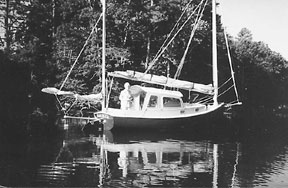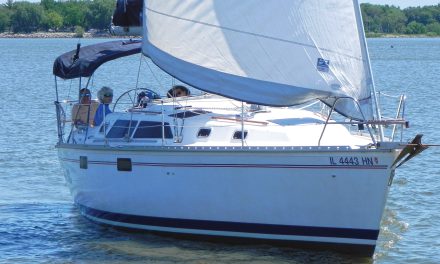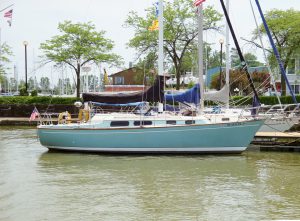
A solid though somewhat stately cruiser
Pearson Yachts set off in a new direction in the 1970s. After the company’s founders, Clint and Everett Pearson, left in the mid-1960s, Bill Shaw took over as general manager and chief designer. His designs had a more contemporary look, with longer waterlines, more beam, moderate displacement, cruising fin keels, and skeg-mounted rudders. Pearson Yachts was firmly committed to building wholesome family cruisers, and leading the new wave of designs were the Pearson 365, Pearson 323, and Pearson 424. Introduced in 1976, the Pearson 323 was a mainstay of the new Pearson cruising-boat lineup for almost a decade.
Lucky Lady is a 1978 Pearson 323 owned by Ken and Eva Gorby. This is their first sailboat; they had previously been dedicated powerboaters. Their daughter, while serving in the U.S. Navy and stationed in Norfolk, Virginia, purchased the boat and enlisted her dad to help her fix it up. One thing led to another, the daughter was deployed elsewhere, and the saga of repairs and upgrades continues.
Design
Compared to earlier Pearson designs that were influenced by the Cruising Club of America (CCA) measurement rule for racing, the 323 is a departure. Explaining his approach to its design, Bill Shaw said, “I set about to design an honest cruising boat with youthful ideas and an international flavor. The 323’s underbody configuration is as modern as her profile is traditional. To look fast is one thing. To go fast in comfort is quite another.”
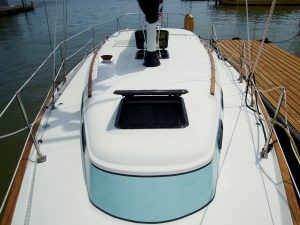
The sidedecks are wide and the shrouds are outboard, above right. The elevated toerail assures secure footing.
With its sharp entry, long waterline, sweet sheer, and slightly rounded vertical transom, the 323’s hull looks sleek and powerful. A major design goal was to create volume in the interior, so the cabin trunk is quite tall. To minimize its visual impact, a wide black stripe, affectionately referred to as the raccoon or bandit stripe, encircled the entire cabin trunk. Black-anodized spars complemented this step toward modernism. The Gorbys softened the effect by painting the raccoon stripe to match the boat’s teal-colored hull and painting the spars white.
Construction
The hull of the Pearson 323 is a solid laminate of hand-laid fiberglass and polyester resin. The deck is of sandwich construction, with a core of end-grain balsa between two skins of fiberglass. Sandwich construction achieves the desired strength and rigidity while being lighter than solid fiberglass, and Everett Pearson was a pioneer in the use of end-grain balsa as a core material.
The hull-to-deck joint is bonded chemically, mechanically fastened with self-tapping stainless steel screws that also secure the teak toerail in place, and taped on the inside with fiberglass and resin.
Although much of the boat’s interior is teak-veneered marine-grade plywood and solid wood trim, Pearson used a fiberglass pan
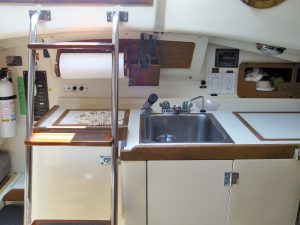
The galley in the Pearson 323 is normally fitted with a 2- or 3-burner propane stove and oven. Because her owners use Lucky Lady primarily as a daysailer, they have removed the stove and replaced it with a microwave oven and electric refrigerator.
and overhead liner. The pan is the base for settees, lockers, and other cabin furniture. Overhead in the saloon is a removable sheet of plastic laminate secured with teak battens. While a fiberglass liner might offer some structural advantages, the main reason builders use moldings for the interior is to reduce costs.
The ballast — 4,500 pounds of lead — is internal, so there are no keel bolts. It is set inside the keel, which is an integral part of the hull molding, and glassed over. The rudder is supported at its foot by a bearing attached to the skeg, which itself protects the rudder in the event of a grounding or collision with an underwater object.
The 323’s standard auxiliary power is the ubiquitous gasoline Universal Atomic 4 driving a two-blade propeller. Fuel is supplied from a 30-gallon tank that appears to be made of galvanized steel. A 2-cylinder Volvo Penta diesel was offered as an option. Both engines were coupled to a Walter V-drive. In reverse gear the 323 walks to port.
The Rig
The Pearson 323 is a masthead sloop with a sail area of 478 square feet on a single-spreader mast supported with cap shrouds and forward and aft lower shrouds, all ¼-inch stainless steel wire. A boom lift is attached to the single backstay. Bridge clearance is 45 feet 4 inches.
The rig is simple and powerful and can be easily handled by a singlehander or a short-handed crew. The double-braid main and headsail halyards are external. They lead to Lewmar #8 single-speed winches on the mast and are made fast to cleats mounted just below the winches. Jiffy reefing with a single reef point in the mainsail was standard. The mainsheet is attached to a traveler that runs across the aft portion of the bridge deck.
A 9-foot genoa track is mounted on the teak toerail on each side of the boat and the headsail sheets lead aft to Lewmar #40 two-speed winches on the cockpit coamings. Two cleats, a jam cleat, and an open-throat cleat are fitted near each winch.
With its displacement/length ratio a moderate 275 and a low sail area/displacement ratio of just 14, the 323 is somewhat underpowered.
Deck features
The 323’s deck is pure simplicity and functionality. At the bow, there’s a no-nonsense stemhead fitting and a pair of open-throat cleats. Just aft of the cleats is an anchor locker that drains overboard. The rest of the foredeck is free of obstructions.
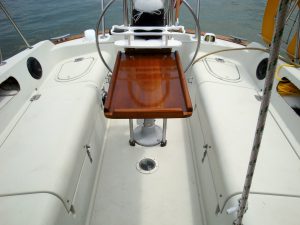
Rounded corners on the cockpit seats were a Pearson feature in the 1970s. The cockpit seat lockers are the means of access to the engine, water heater, batteries, and the 30-gallon fuel tank. Aft of each seat locker is a propane locker. Surprisingly, there’s no built-in helm seat aft of the 27-inch wheel.
The sidedecks are wide and the shrouds are outboard. A stainless-steel bow pulpit, dual lifelines, teak-capped bulwarks, and 9 feet of teak handrail along the cabintop enhance security and ease of movement.
Forward, on each side of the cabin, is a pair of opening portlights. Aft of them is a pair of rather long smoked-acrylic fixed portlights. On the gently cambered cabintop are two Bowmar hatches, one over the V-berth and the other over the saloon, and a single Dorade vent to starboard, above the saloon. The companionway hatch slide is protected by a sea hood.
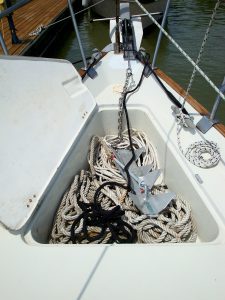
On Lucky Lady, an aftermarket roller aids in stowing and deploying the anchor. The anchor locker has the capacity to easily house 300 feet of rope and chain rode and a spare anchor.
The 323’s cockpit measures over 7 feet in length, with 1 foot of that taken up by a substantial bridge deck. Two 1½-inch scuppers forward in the cockpit footwell discharge below the waterline via through-hulls with seacocks. A pair of coaming cubbies and rather large and cavernous seat lockers port and starboard provide stowage in the cockpit.
A small panel with the engine controls is located in the footwell adjacent to the helm, and some of the gauges are mounted on the face of the bridge deck. A fitting for the emergency tiller is accessible under the cockpit sole aft of the steering pedestal, and there’s also a clear port for viewing the fuel gauge. Completing the picture is a pair of open-throat mooring cleats outboard on the stern, a transom-mounted swim ladder, and a stainless-steel stern pulpit.
Belowdecks
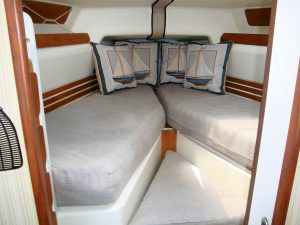
An insert increases the V-berth’s already large area. When placed in its lower position, it becomes a cozy centerline seat.
In the forward cabin, fiddled shelves are fitted port and starboard above the V-berth. Beneath it are three stowage bins. In the forward bin on Lucky Lady is an optional plastic 35-gallon water tank. Aft of the berth and to port is a bureau with drawers and to starboard is a series of open shelves. Much of the plumbing for the head, including the Y-valve and a portion of the plastic holding tank, is behind these shelves. Additional amenities include a pair of reading lights, port and starboard portlights, and an overhead hatch.
A sliding door separates the V-berth from the head compartment, which is finished with white plastic laminate. Lucky Lady is fitted with the optional centerline shower and large teak shower grate. Port and starboard opening portlights illuminate and ventilate this rather small compartment. A folding door separates the head compartment from the saloon.
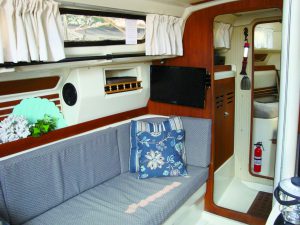
The dinette table swivels to face either the starboard or port settee, at left, and lowers to convert the dinette to a double berth. The molded fiberglass liner is quite elaborate. It forms the sole and the foundations for the berths and covers the sides of the hull, complete with molded-in storage cubbies.
On the port side of the saloon is a single settee berth and on the starboard side a U-shaped dinette with a pole-mounted table. Beneath the dinette there’s a pair of lockers. Plastic 20-gallon water tanks, each with its own deck fill, are fitted under each settee. Stowage is provided behind both settee berths and on shelves and a pair of cubbies above them. A 6-foot-long metal grabrail is fitted on either side just below the two fixed portlights. While some 323s had a teak-and-holly sole, Lucky Lady’s sole is a fiberglass pan with wooden inserts that lift out to allow access to the bilge. The single Dorade vent provides ventilation when the boat is closed up. Headroom is 6 feet 2 inches.
The companionway is offset to starboard. Outboard of it is a compact nav station. Across from the nav station is the L-shaped galley, with one leg of the L along the aft bulkhead. A large top-loading icebox occupies the corner, and other fixtures include a stove with an oven, a single stainless-steel sink with pressurized hot and cold water, and a foot pump for fresh water. For stowage there’s a shallow flatware/cutlery bin, a pair of cubbies for plates and bowls, a reasonably large locker with sliding doors outboard, and a pots-and-pans locker beneath the stove.
A door beneath the galley sink provides access to the freshwater manifold and the engine’s heat exchanger. Removing the companionway ladder makes more of the engine accessible.
Under way
The Pearson 323 sails quite well on both a run and a reach, but is not close-winded. When sailed high on its lines, the 323 sails surprisingly well, but too much gear packed into those cavernous cockpit lockers will weigh down the stern and severely diminish that performance. The boat will heel quickly to 17 degrees, more in really heavy air, and needs a reef before the wind reaches 15 knots.
Things to check out
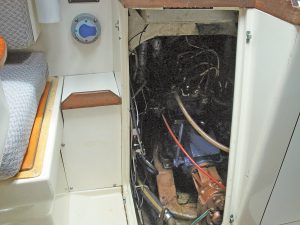
Servicing the engine is not easy despite several access points. Some operations vary between the Universal Atomic 4 gas engine and the Volvo diesel.
As the youngest Pearson 323 is 30 years old and the oldest nearing 40, much of the must-do maintenance on this good old boat will be due to its age. Leaking portlights are common, and so are hull blisters. Delamination of the deck’s balsa core does occur, especially in areas where hardware is mounted. Because crevice corrosion weakens stainless steel, fittings that should be inspected and might possibly need to be replaced include the chainplates and the mast step.
Conclusion
Generally speaking, the Pearson 323 has aged quite well compared to its contemporaries. Over its 10-year production run, several options were offered. While a few of them were performance oriented, most dealt with creature comforts, which speaks well for its cruising emphasis. While a large number of 323s were built, usually only a handful are offered for sale at any one time. Prices range from $11,000 to $16,000, depending upon condition and equipment. Those interested in the boat can check out the internet and the very active owners association.
Resources
Comments from Pearson 323 owners
I like the cockpit, especially the well-rounded seat edges that allow for comfortable sitting for hours, even without cushions. I don’t like the low boom. It’s a real head knocker and also really puts limits on a dodger.
–Peggy Kapisovksy, Georgetown, Maine
The 323 is very headsail-driven. With the moderate to heavy winds we have around here — generally 20+ knots in summer — I am often overpowered with a 100 percent jib, and I let the main luff. In some cases I drop the main and rely on the jib alone. She balances well, and, surprisingly, points as high without the main.
–Paul Morgan-Witts, San Francisco, California
I rebuilt the mast step because the old one looked terrible (rusty) but it actually had a lot of intact metal. I repowered with a Universal. My advice for someone considering buying this boat? Repowering the engine and V-drive will cost near the value of the boat, even as a DIY job — $15,000.
–Dan Haun, New Orleans, Louisiana
It is comparatively slow. I tell friends I can pass other boats — they just have to be moving in the opposite direction. It doesn’t point particularly well, but well enough. My greatest complaint is that the boat is very difficult to work on because of the cramped quarters. I wanted to replace the bow roller and it was simply impossible to reach the bolts. Much work must be done blind, if you can reach it at all.
–Steve Hayes, Readfield, Maine
The engine compartment is very hard to access. With the V-drive transmission, I have no idea how anyone can access the packing gland on the prop shaft. You have to just about do a headstand to simply check the fuel level.
–John Speck, San Francisco Bay, California
Some of my chainplates snapped during a crossing of the Gulf of Mexico. That was really my fault for thinking 30-year-old stainless steel was still strong. I have replaced them all.
–Dave McGovern, St. Mary’s, Georgia
Ceilidh was solidly built, never “oil-canned,” and was structurally sound. Her keel, which is part of the hull, took a major hit when it struck a sharp underwater object at cruising speed. It took a gouge out of the front but that was all.
–Clifford and Bezy McKay, Winter Park, Florida
The 323 was built like a tank and just loved being out in the weather. I never felt overwhelmed by the boat; it seemed to just want to shoulder down and lay into it.
–Dave Breski, Cape Cod, Massachusetts


